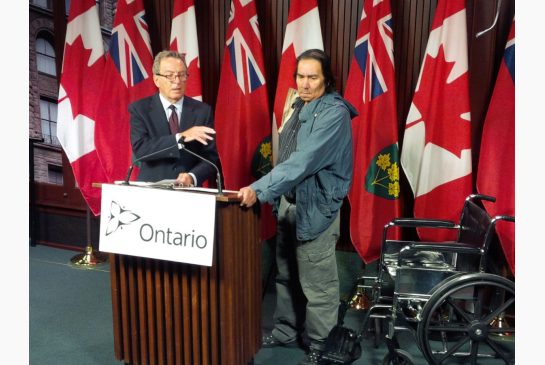Tales from an Ojibway Chief: Truth to Power
I had just finished the post below about Steve Fobister when I found out about his recent hunger strike. Read about it first here.
There are hereditary Chiefs in the Ojibway clan system who tend to come from the Crane and Loon clans. There are elected
Chiefs as well, and Steve Fobister was the youngest man to be elected Chief of Grassy Narrows First Nation Reserve on the English River in the 1970’s.
Steve was elected because he boldly spoke truth to power when it was discovered that the Dryden Pulp and Paper Company had been dumping mercury into the English River, that the methyl-mercury had been biomagnified as it always will be, and that the walleye the Ojibway relied on as a major part of their diet were toxic and were poisoning them.
He spoke up in dramatic fashion in the early days when even after the Canadian government and Dryden Pulp acknowledged the mercury had been dumped in the English River they continued to vigorously deny that the serious health problems the residents of Grassy Narrows and neighboring White Dog reserve were suffering–White Dog is also on the English River–were in any way related to the mercury in the fish.
Doctors who attended the residents of the reserves in those early days adopted a common line–nationalized health meant they were employed by the government. They stated “Perhaps these health problems are what occurs when an aboriginal population suddenly take on a modern diet.” Steve’s response was “Sure, that’s right, this is what happens when our modern diet is laced with mercury.”
Since the Ojibway had signed away their rights to sue the Canadian government when they signed their peace treaties in the 1880’s and because that legal protection extended to Crown Corporations and Dryden was the subsidiary of one, no one was accepting they had any legal responsibility to help these folks and absent a legal responsibility no one stepped up to take on a basic humanitarian obligation. After all Grassy Narrows was in the wilderness, far away from the media, easy to ignore.
Then one day Steve learned a reporter was visiting Grassy Narrows to follow up on another story; Steve tracked him down and told him that if he wanted a really big story, a block bluster of a story, he should come back with a camera crew and Steve would tell them of the proof he had that white men were raping Ojibway women on the Reserve in a systematic fashion.
When a few days later the media returned in large numbers Steve was ready. He introduced them to four women who were suffering the early stages of what has come to be known as Minamata Disease, after the first major mercury poisoning event in Japan, in Minamata Bay. He showed reporters the research he had done linking methyl-mercury and the symptoms found in these women and in more and more residents all the time. It was the event that broke open the story.
Later, when Steve was negotiating with American factory owners who were being challenged in courts by the Canadian government for the pollution damage caused in Canada by the factories close to the border, Steve was intercepted by the Royal Canadian Mounted police and taken to then Prime Minister Pierre Trudeau who asked Steve if he knew what the punishment was for treason. Steve replied, “No, but I have wondered many times what the punishment for genocide is.”
Steve has given so much to this fight. It was my great blessing to work with him for four summers when we were boys learning to become men. My writing is motivated by a need to honor him.




schkweidy altime
August 20, 2014 at 1:42 pmI wonder why there isn’t any comments to this story from any of the people who comment on other stories? I have family that have been poisoned from the mercury and are suffering from it with the shakes, constantly getting sick…SHAME on canada for doing this dor the all mighty dollar.